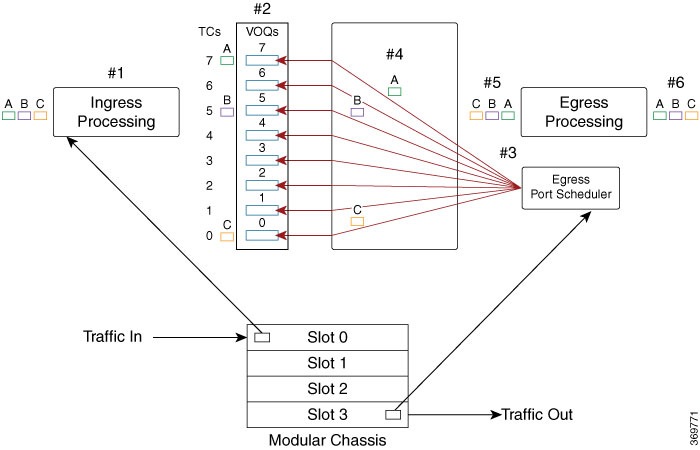Traffic management with VOQs
A traffic management model with Virtual Output Queue (VOQ) is a QoS queuing architecture that
-
enables per-egress interface queuing at ingress using VOQs
-
prevents head-of-line (HOL) blocking by isolating traffic destined for different egress interfaces, and
-
provides granular control over network traffic congestion and bandwidth allocation for data packets.
VOQs—VOQs are buffers at the ingress that holds traffic for a specific egress port, ensuring traffic is queued only when the destination is ready to receive. Your routers support up to eight output queues per main interface or physical port. For every egress output queue, the VOQ model earmarks buffer space on every ingress pipeline. This buffer space is in the form of dedicated VOQs. These queues are called virtual because the queues physically exist on the ingress interface only when the line card actually has packets enqueued to it.
Head-of-line blocking—In traditional ingress queuing systems, traffic destined for multiple egress ports may be held in a single shared queue. If the egress port for the first packet is congested, all subsequent packets—even those destined for other non-congested ports—are blocked from forwarding. This effect is referred to as head-of-line blocking and results in reduced traffic throughput and increased latency.
Key features of VOQ-based traffic management
These are the key features of the VOQ-based traffic management model:
-
Per-egress Queuing at Ingress: Virtual Output Queues are created per traffic class and per egress interface, allowing granular traffic isolation and precise scheduling.
-
Eight VOQs per Egress Port: For each egress interface, eight VOQs—corresponding to eight traffic classes—are reserved across all ingress interfaces, ensuring efficient prioritization of data packets.
For more information on the various types of traffic classes and packet classification, see Classify Packets to Identify Specific Traffic.
-
Head-of-line Blocking Prevention: By dedicating VOQs for each destination, the model eliminates congestion caused by blocked packets for other egress ports.
-
Dynamic VOQ Instantiation: VOQs are created only when packets are present, optimizing buffer usage across ingress pipelines.
-
Connector Mesh: A logical mesh of connectors enables integrated handling of credit requests, grant responses, and data transmission between ingress and egress.
-
Credit-Based Scheduling: Egress ports issue credits to ingress VOQs based on availability, ensuring bandwidth is distributed according to QoS priorities.
-
Throughput Optimization and Loss Reduction: The architecture minimizes packet drops during congestion and maximizes throughput by forwarding only when the egress is ready.
Benefits of VOQ model
The VOQ-based traffic management model improves traffic handling efficiency and network performance by introducing a queuing architecture that
-
reduces head-of-line blocking by separating queues per egress destination,
-
minimizes packet drops by queuing only when egress resources are available, and
-
supports lossless packet forwarding for high-priority traffic under congestion scenarios.
|
Non-VOQ-based traffic management |
VOQ-based traffic management |
|---|---|
|
Ingress queues traffic without visibility into egress port availability. |
Ingress buffers traffic per egress port using dedicated VOQs. |
|
Prone to congestion due to head-of-line blocking. |
Prevents head-of-line blocking by isolating queues per destination. |
|
Inefficient use of bandwidth when packets are dropped mid-pipeline at ingress due to congestion at the egress. |
Minimizes wastage of router resources by dropping traffic packets only at ingress when egress is unavailable. |


 Feedback
Feedback